Design Method and Impact Response of Energy-Consuming High-Fall Flexible Protection System for Construction
Abstract
:1. Introduction
2. Existing Protection System
3. Conception of the System
3.1. Composition
3.2. Working Mechanism
4. Design Method
4.1. Energy Matching
4.2. Component Internal Force Balance
4.3. Two-Level Energy Consumption Mechanism
5. System Simulation
5.1. Model Design
5.2. Simulation of Interception Net
5.3. Simulation of Energy Dissipator
5.4. Finite Element Model
5.5. Simulation Cases
6. Result Analysis
6.1. System Deformation
6.2. Energy Consumption Distribution
6.3. Internal Force of Components
6.4. Discussion
7. Conclusions
- (1)
- This study set out to develop a high-fall flexible protection system with much stronger energy consumption than traditional protection systems, solving the problem of large-scale impact protection similar to the overall fall of mold equipment, thereby improving construction safety.
- (2)
- The novelty of the system lies in the use of steel wire mesh as the interception component and the use of energy dissipators as the energy-consuming component, achieving high energy consumption capacity.
- (3)
- The proposed design method considers system energy matching, component internal force balance, and two-stage energy consumption, which can achieve the scientific and quantitative design of high-altitude flexible protection systems.
- (4)
- These simulations confirmed that compared with the system without an energy dissipation mechanism, the system with a tensile yield energy dissipation mechanism can reduce the internal force of its key components by about 60% and increase the anti-falling impact capacity more than six times.
- (5)
- The study is limited by the lack of practical engineering applications. The convenience and economy of the system have not been verified yet.
- (6)
- Future studies should pay attention to the high energy impact protection of non-opening parts, and carry out special research on its application to the high-fall damage protection of construction personnel.
Author Contributions
Funding
Data Availability Statement
Conflicts of Interest
References
- OSHA (Occupational Safety and Health Administration). OSHA Commonly Used Statistics. 2019. Available online: https://www.osha.gov/data/commonstats (accessed on 7 May 2021).
- OSHA (Occupational Safety and Health Administration). Safety and Health Regulations for Construction: Fall Protection (Standard 29 CFR 1926, SubpartM). Available online: https://www.osha.gov/lawsregs/regulations/standardnumber/1926/1926.502 (accessed on 23 May 2021).
- HSE, 2020. Health and Safety Executive. Workplace Fatal Injuries in Great Britain. Available online: http://www.hse.gov.uk/statistics/pdf/fatalinjuries.pdf (accessed on 5 March 2023).
- Ma, Z. Statistical analysis of safety production accidents in construction field. Architecture 2022, 3, 52–55. [Google Scholar]
- Safework, A. Work-related Traumatic Injury Fatalities, Australia. 2019. Available online: https://www.safeworkaustralia.gov.au/doc/work-related-traumatic-injury-fatalities-australia-2019 (accessed on 6 March 2023).
- Ling, F.Y.Y.; Liu, M.; Woo, Y.C. Construction fatalities in Singapore. Int. J. Project Manag. 2009, 27, 717–726. [Google Scholar] [CrossRef]
- Korea Occupational Safety and Health Agency. 2018 Industrial Accident Status Analysis. 2018. Available online: https://www.kosha.or.kr/english/index.do (accessed on 6 March 2023).
- Kim, J.M.; Son, K.; Yum, S.G.; Ahn, S. Analyzing the risk of safety accidents: The relative risks of migrant workers in construction industry. Sustainability 2020, 12, 5430. [Google Scholar] [CrossRef]
- Ren, G. The removal of the anti-fall device led to the fall of the climbing frame and the illegal cross-operation caused the accident to expand—Analysis of a Larger Accident of Falling of Attached Lifting Scaffolding in “3.21” Attached Lifting Scaffolding of AVIC Baosheng Offshore Engineering Cable Project in Yangzhou, Jiangsu Province. Jilin Labor Prot. 2019, 9, 39–41. [Google Scholar]
- Office of the Work Safety Committee of the State Council. Notification from the Office of the State Council Safety Commission on the “9.10” Major Attached Scaffold Fall Accident at the Kaixuan Building Construction Site on Xuanwu Road, Xi’an City, Shaanxi Province. In Proceedings of the Gazette of the State Administration of Work Safety and the State Administration of Coal Mine Safety, Xi’an, China, 14–15 October 2011. [Google Scholar]
- Zhong, B.; Pan, X.; Love, P.E.D.; Ding, L.; Fang, W. Deep learning and network analysis: Classifying and visualizing accident narratives in construction. Autom. Constr. 2020, 113, 103089. [Google Scholar] [CrossRef]
- Ma, F.; Zhang, D.; Wang, Z.; Chen, X.; Jiang, L. Risk Assessment of Falling Objects from Façades of Existing Buildings. Buildings 2023, 13, 190. [Google Scholar] [CrossRef]
- Ansari, R.; Dehghani, P.; Mahdikhani, M.; Jeong, J. A Novel Safety Risk Assessment Based on Fuzzy Set Theory and Decision Methods in High-Rise Buildings. Buildings 2022, 12, 2126. [Google Scholar] [CrossRef]
- Halabi, Y.; Xu, H.; Long, D. Causal factors and risk assessment of fall accidents in the U.S. construction industry: A comprehensive data analysis (2000–2020). Saf. Sci. 2022, 146, 105537. [Google Scholar] [CrossRef]
- Newaz, M.T.; Ershadi, M.; Carothers, L.; Jefferies, M.; Davis, P. A review and assessment of technologies for addressing the risk of falling from height on construction sites. Saf. Sci. 2022, 147, 105618. [Google Scholar] [CrossRef]
- Semeykin, A.Y.; Klimova, E.; Nosatova, E.; Khomchenko, Y.V. Using of automated risk assessment systems to ensure the safety of personnel at construction sites. IOP Conf. Ser. Mater. Sci. Eng. 2020, 945, 012022. [Google Scholar] [CrossRef]
- Łabęd’z, P.; Skabek, K.; Ozimek, P.; Nytko, M. Histogram Adjustment of Images for Improving Photogrammetric Reconstruction. Sensors 2021, 21, 4654. [Google Scholar] [CrossRef]
- Lu, Y.; Gong, P.; Tang, Y.; Sun, S.; Li, Q. BIM-integrated construction safety risk assessment at the design stage of building projects. Autom. Constr. 2021, 124, 103553. [Google Scholar] [CrossRef]
- Wang, Z.; Wu, Y.; Yang, L.; Thirunavukarasu, A.; Evison, C.; Zhao, Y. Fast personal protective equipment detection for real construction sites using deep learning approaches. Sensors 2021, 21, 3478. [Google Scholar] [CrossRef] [PubMed]
- Zuluaga, C.M.; Albert, A.; Winkel, M.A. Improving safety, efficiency, and productivity: Evaluation of fall protection systems for bridge work using wearable technology and utility analysis. J. Construct. Eng. Manag. 2020, 146, 04019107. [Google Scholar] [CrossRef]
- Çelik, G.T.; Aydınlı, S.; Bazaati, S. Safety net applications in developing countries: Turkey and Iran case study. J. Constr. Eng. Manag. Innov. 2021, 4, 12–21. [Google Scholar] [CrossRef]
- Filho, M.C.A.; Serra, S.M.B. Comparison between collective protective systems in Brazil: Safety platforms and safety net type V. SN Appl. Sci. 2020, 2, 2153. [Google Scholar] [CrossRef]
- Eulogio, E.S.; Más, R.I. Energy Absorption of Safety Nets in Building Construction [C/OL]//Structures under Shock and Impact the New Forest; WIT Press: Southampton, UK, 2006; pp. 421–429. [Google Scholar]
- Chen, Y. Experimental Research and Numerical Simulation of Protective Performance of Safety Nets in High-Rise Building Construction; Southwest Jiaotong University: Chengdu, China, 2022. [Google Scholar]
- Yu, Z.X.; Zhao, L.; Liu, Y.P. Studies on flexible rockfall barriers for failure modes, mechanisms and design strategies: A case study of western china. Landslides 2019, 16, 347–362. [Google Scholar] [CrossRef]
- Darve, F.; Li, X.; Zhao, J. A Unified CFD-DEM Approach for Modeling of Debris Flow Impacts on Flexible Barriers. Int. J. Numer. Anal. Methods Geomech. 2018, 42, 1643–1670. [Google Scholar]
- Jin, Y.-T.; Yu, Z.-X.; Luo, L.-R.; Zhang, L.-J.; Xu, H.; Qi, X. A study on energy dissipation mechanism of a guided flexible protection system under rockfall impact. J. Vib. Shock 2021, 40, 177–185+192. [Google Scholar]
- Qi, X.; Yu, Z.-X.; Zhang, L.-J.; Xu, H.; Li, Z.-M. Normalization analysis of puncture force of steel wire ring net. J. Vib. Shock 2021, 40, 178–186. [Google Scholar]
- Guo, L.-P.; Yu, Z.-X.; Luo, L.-R.; Qi, X.; Zhao, S.-C. An Analytical Method of Puncture Mechanical Behavior of Ring Nets Based on the Load Path Equivalence. Eng. Mech. 2020, 37, 129–139. [Google Scholar]
- Xu, H.; Gentilini, C.; Yu, Z.; Qi, X.; Zhao, S. An energy allocation based design approach for flexible rockfall protection barriers. Eng. Struct. 2018, 173, 831–852. [Google Scholar] [CrossRef]
- Zhao, S.C.; Yu, Z.X.; Wei, T.; Qi, X. Test study of force mechanism and numerical calculation of safety netting system. China Civ. Eng. J. 2013, 46, 122–128. [Google Scholar]
- Qi, X.; Xu, H.; Yu, Z.; Zhao, L.; Meng, Q. Dynamic Mechanical Property Study of Break Rings in Flexible Protective System. Eng. Mech. 2018, 35, 188–196. [Google Scholar]
- Yu, Z.-X.; Zhang, L.-J.; Luo, L.-R.; Jin, Y.-T.; Zhao, L.; Qi, X.; Zhao, S.-C. Study on impact resistance of a resilient steel canopy protection system. Chin. J. Rock Mech. Eng. 2020, 39, 2505–2516. [Google Scholar]
- Wang, M.; Shi, S.; Yang, Y. Static tensile test and FEM dynamic simulation for a ring-brake energy disspater. J. Vib. Shock 2011, 30, 188–193. [Google Scholar]
- Gottardi, G.; Govoni, L. Full-scale Modelling of Falling Rock Protection Barriers. Rock Mech. Rock Eng. 2010, 43, 261–274. [Google Scholar] [CrossRef]
- Zhao, Y.; Yu, Z.; Zhao, S. Numerical computing method for a flexible passive network structure with multi-span distributed ring-net. J. Vib. Shock 2019, 38, 211–219. [Google Scholar]
- Yu, Z.; Luo, L.; Liu, C. Dynamic response of flexible rockfall barriers with different block shapes. Landslides 2021, 18, 2621–2637. [Google Scholar] [CrossRef]
- Qi, X.; Xu, H.; Yu, Z. Full-scale test and numerical simulation of guided flexible protection system under a blasting load. Environ. Eng. Geosci. 2020, 26, 243–256. [Google Scholar] [CrossRef]
- Zhao, L.; Yu, Z.X.; Liu, Y.P. Numerical simulation of responses of flexible rockfall barriers under impact loading at different positions. J. Constr. Steel Res. 2020, 167, 105953. [Google Scholar] [CrossRef]
- Wang, L.; Zhang, X.; Wei, X.; Liang, W.; Zhang, W. Research and Application of Safety Net Hanging Technology in Steel Structure Construction of Super Tall Buildings. Constr. Technol. 2015, 44, 34–36. [Google Scholar]
- Noh, G.; Bathe, K.J. An explicit time integration scheme for the analysis of wave propagations. Comput. Struct. 2013, 129, 178–193. [Google Scholar] [CrossRef]
- Noh, G.; Ham, S.; Bathe, K.J. Performance of an implicit time integration scheme in the analysis of wave propagations. Comput. Struct. 2013, 123, 93–105. [Google Scholar] [CrossRef]
- Livermore Software Technology Corporation (lstc), LS-DYNA_Manual_Volume_I_R11. 2018. Available online: https://ftp.lstc.com/anonymous/outgoing/jday/manuals/LS-DYNA_Manual_Volume_I_R11.pdf (accessed on 5 March 2023).
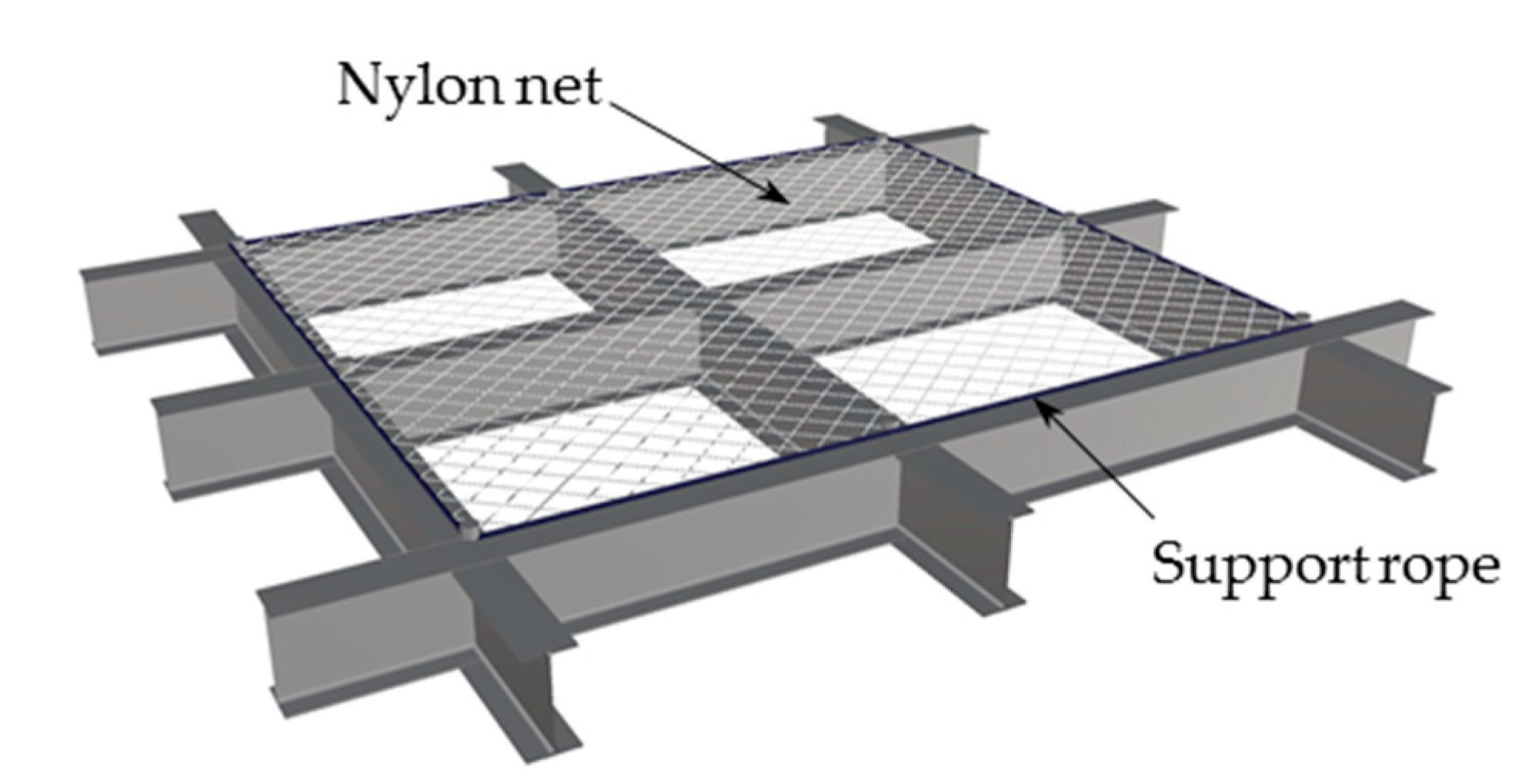

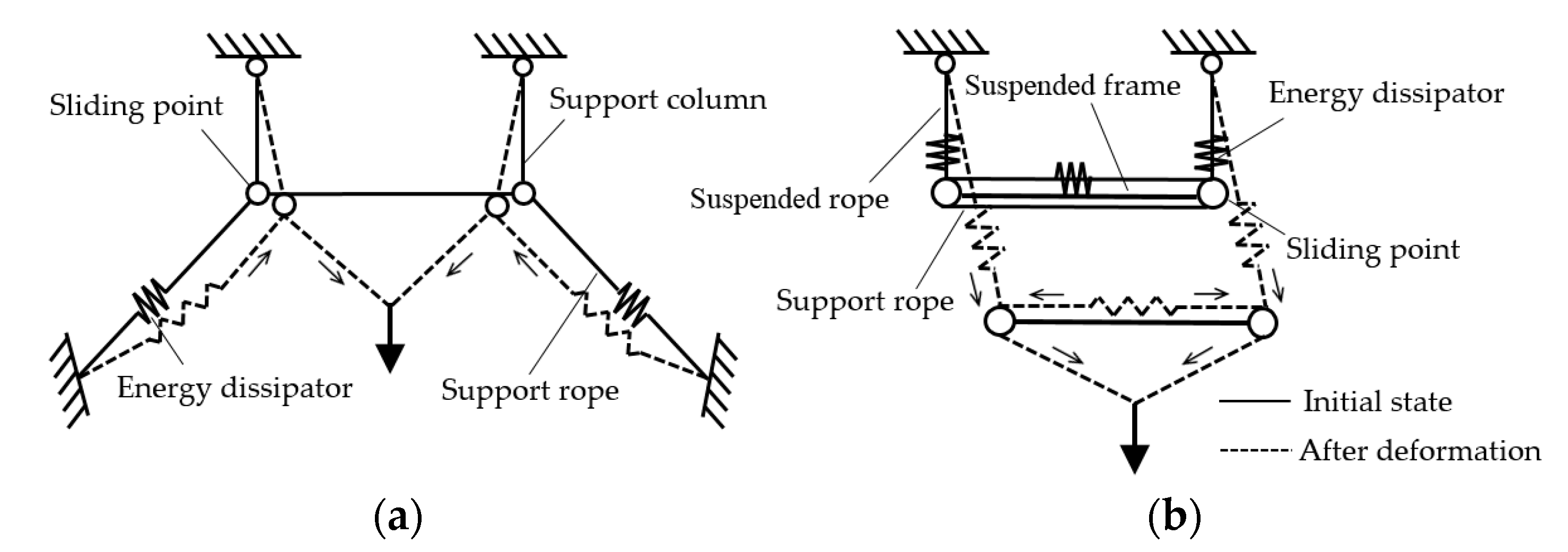
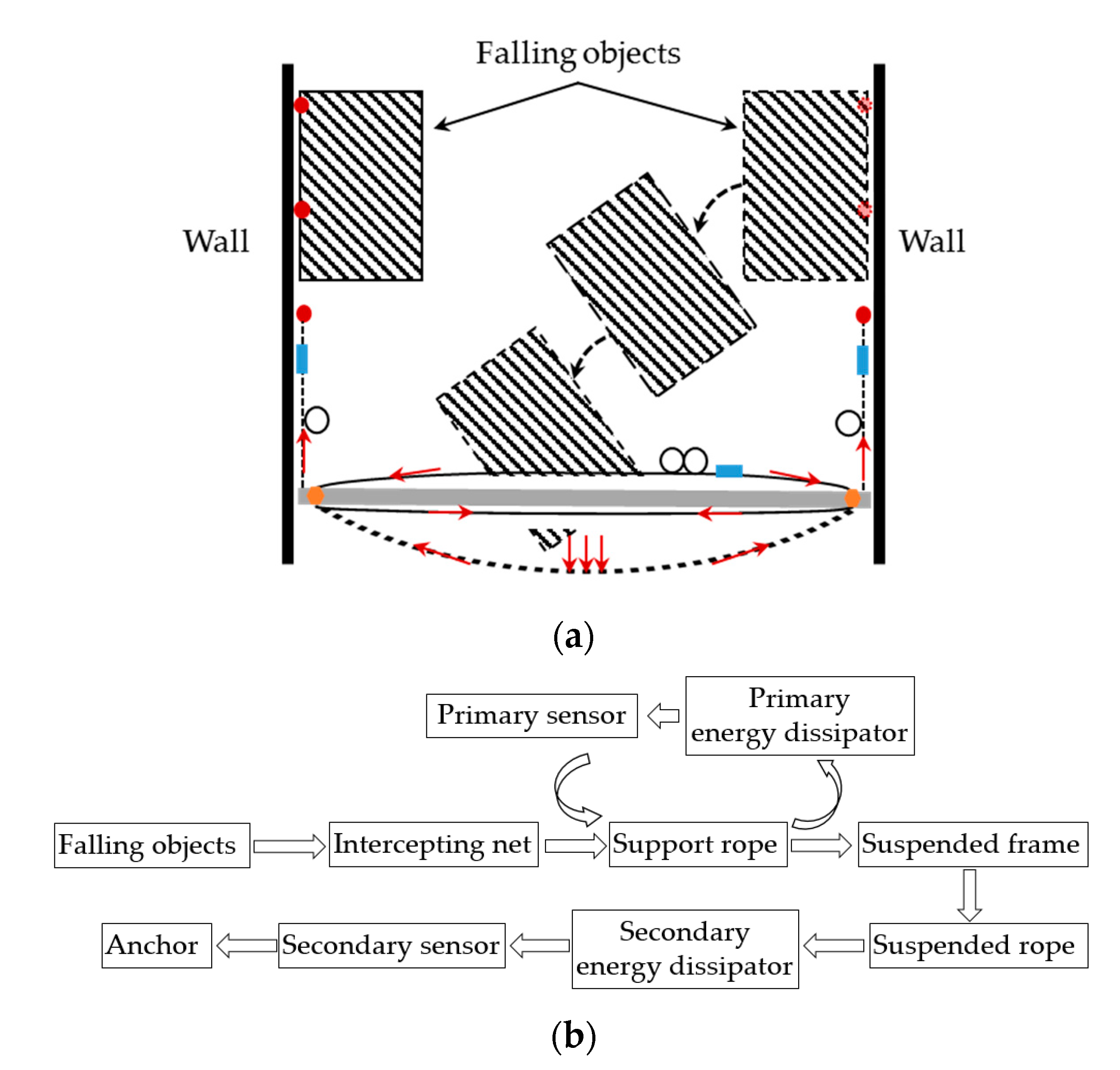

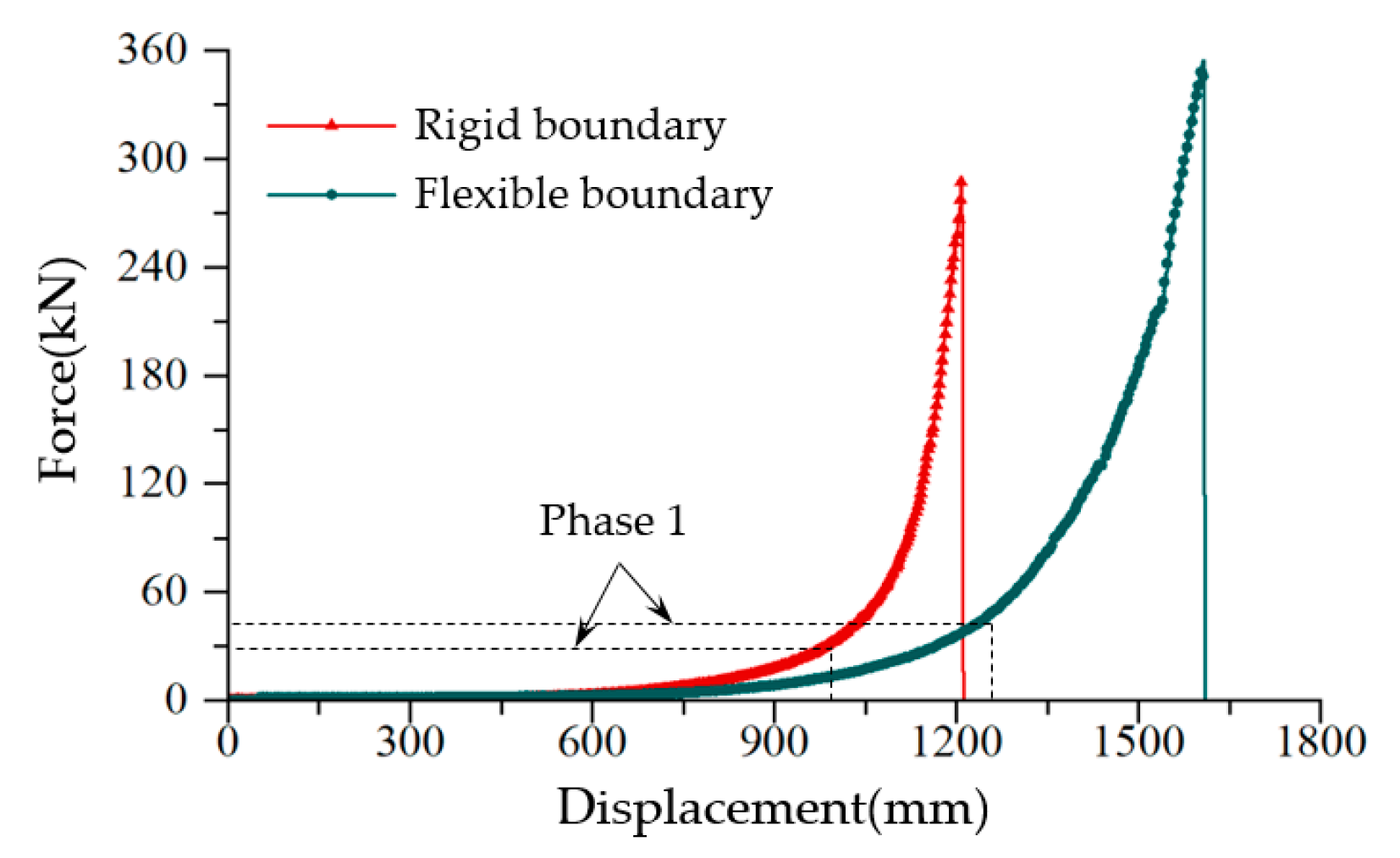
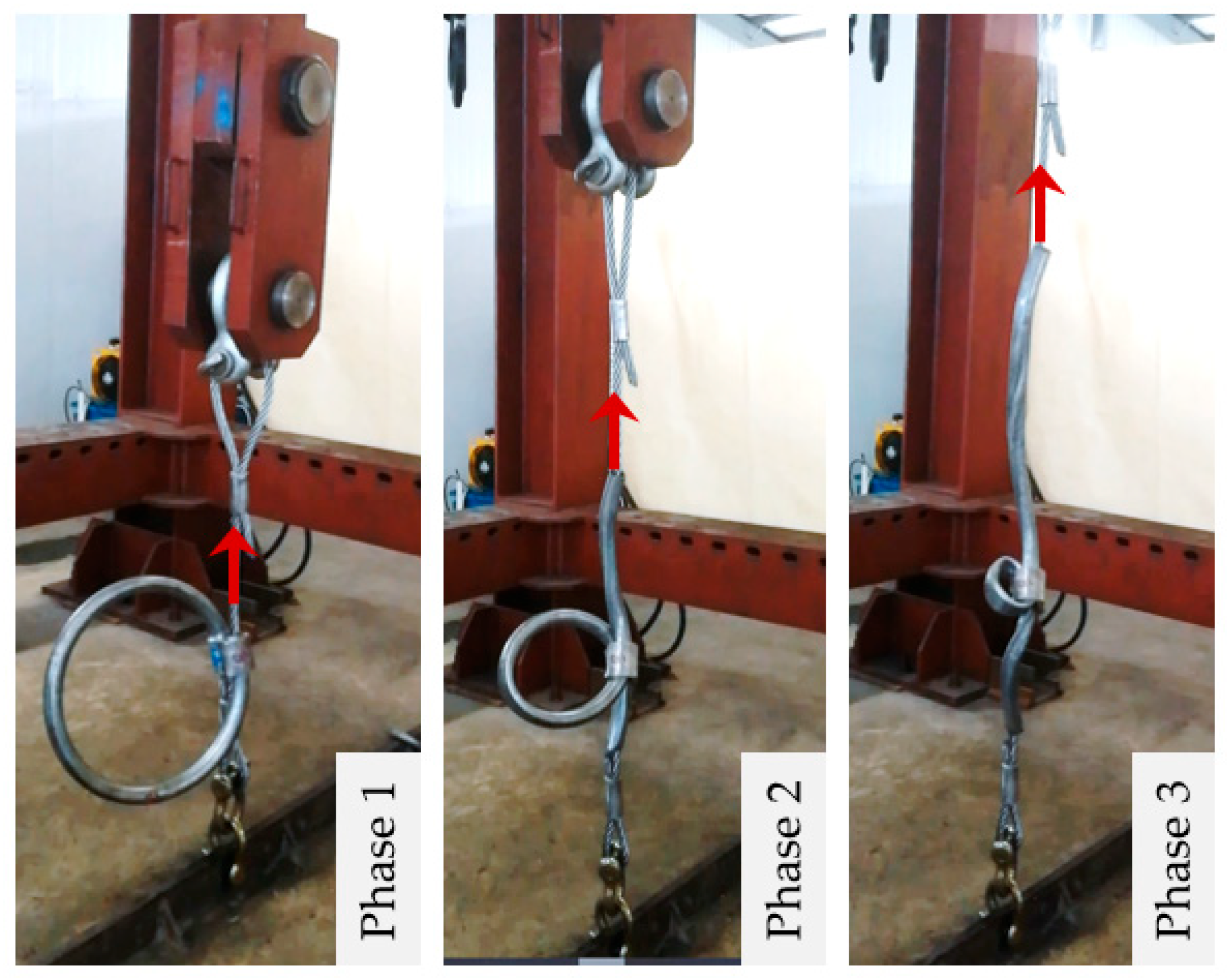

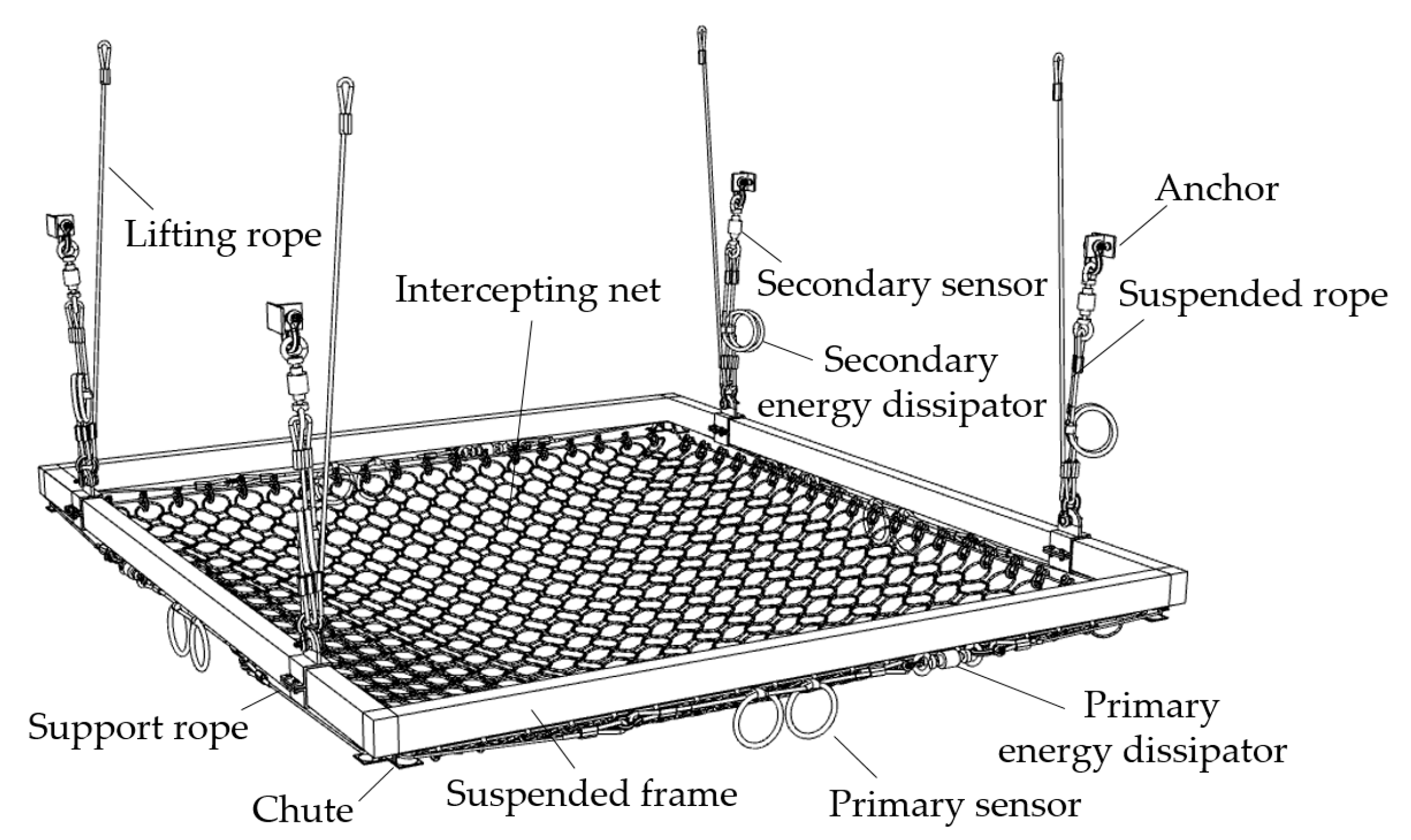
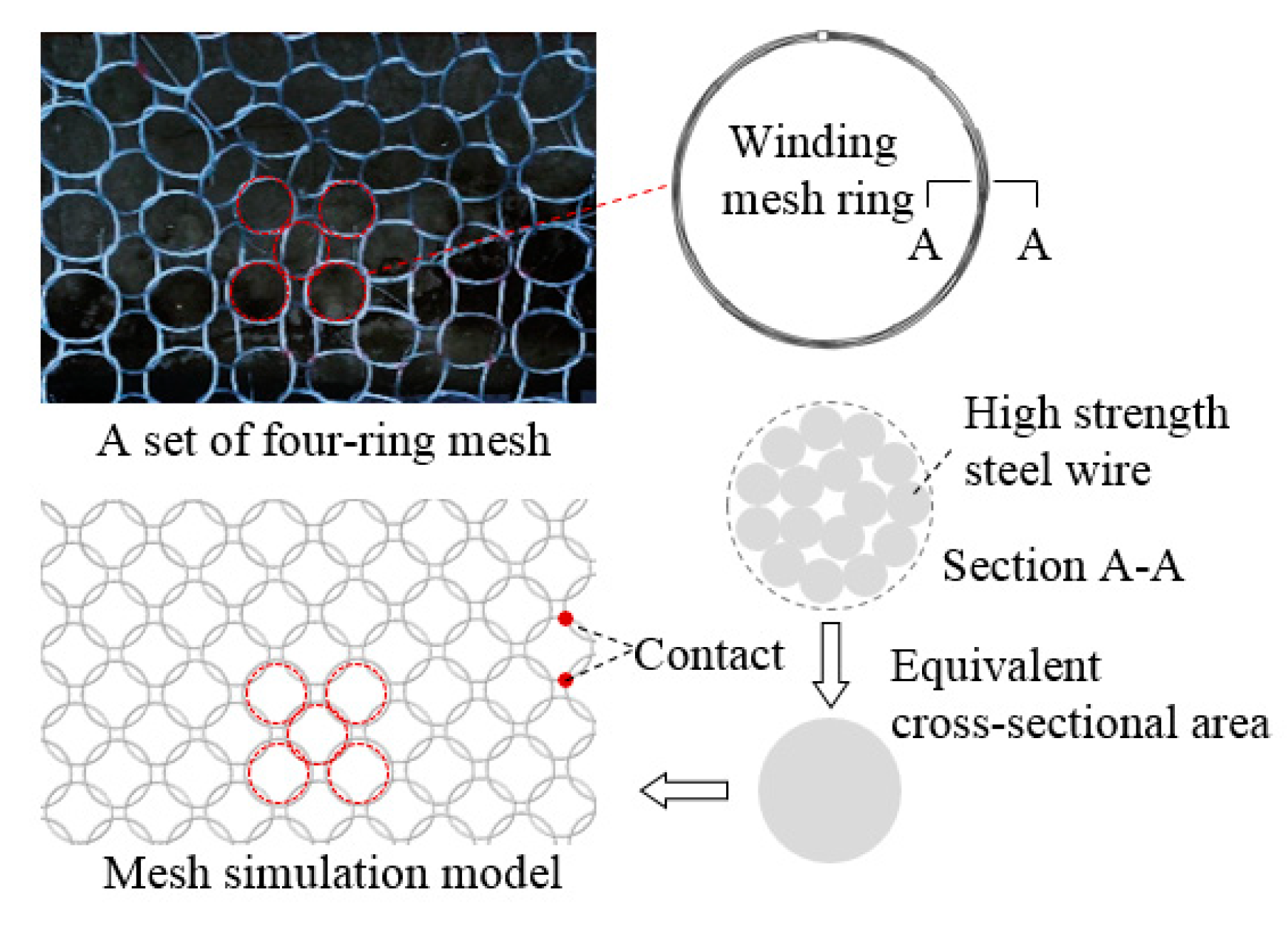


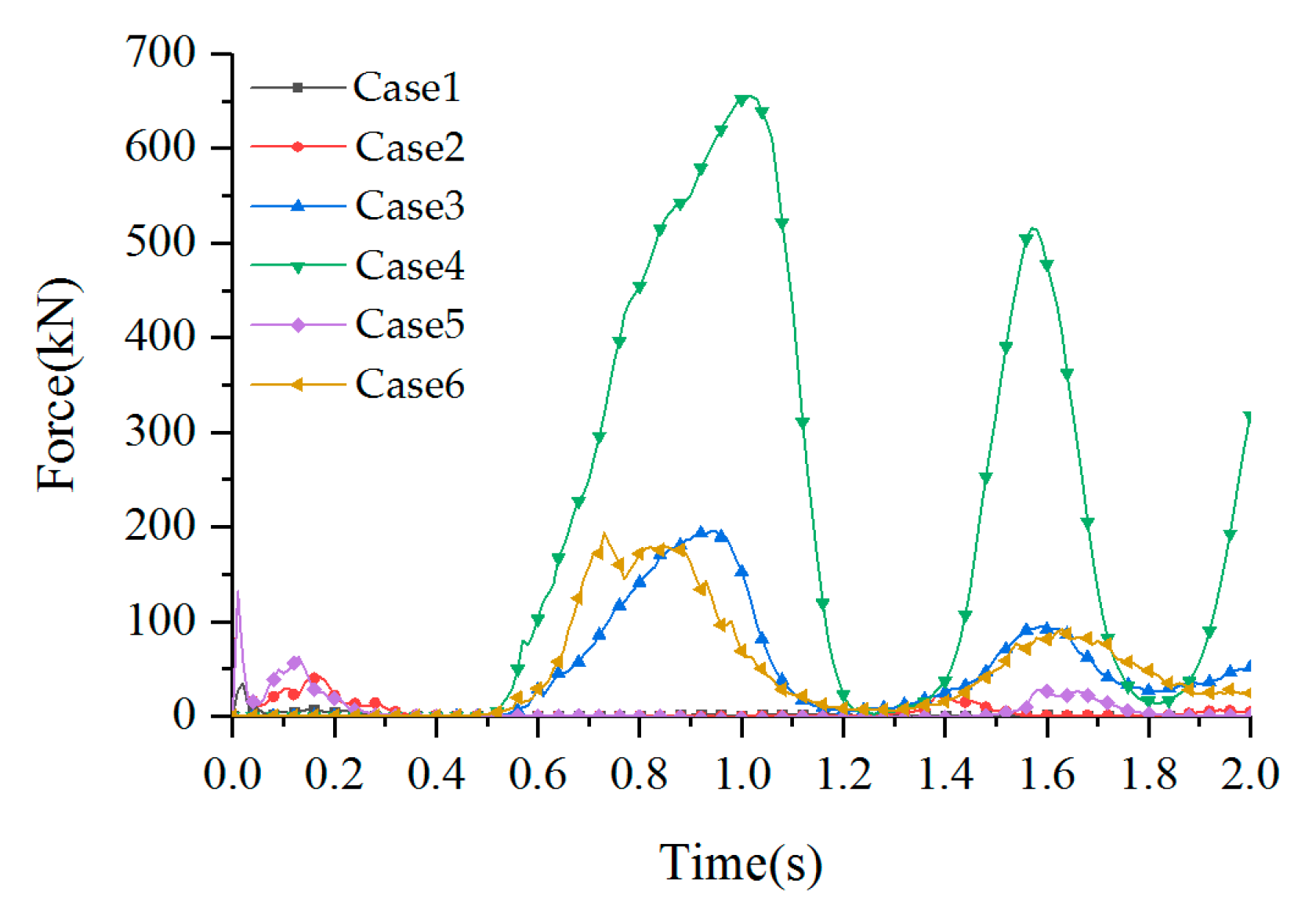
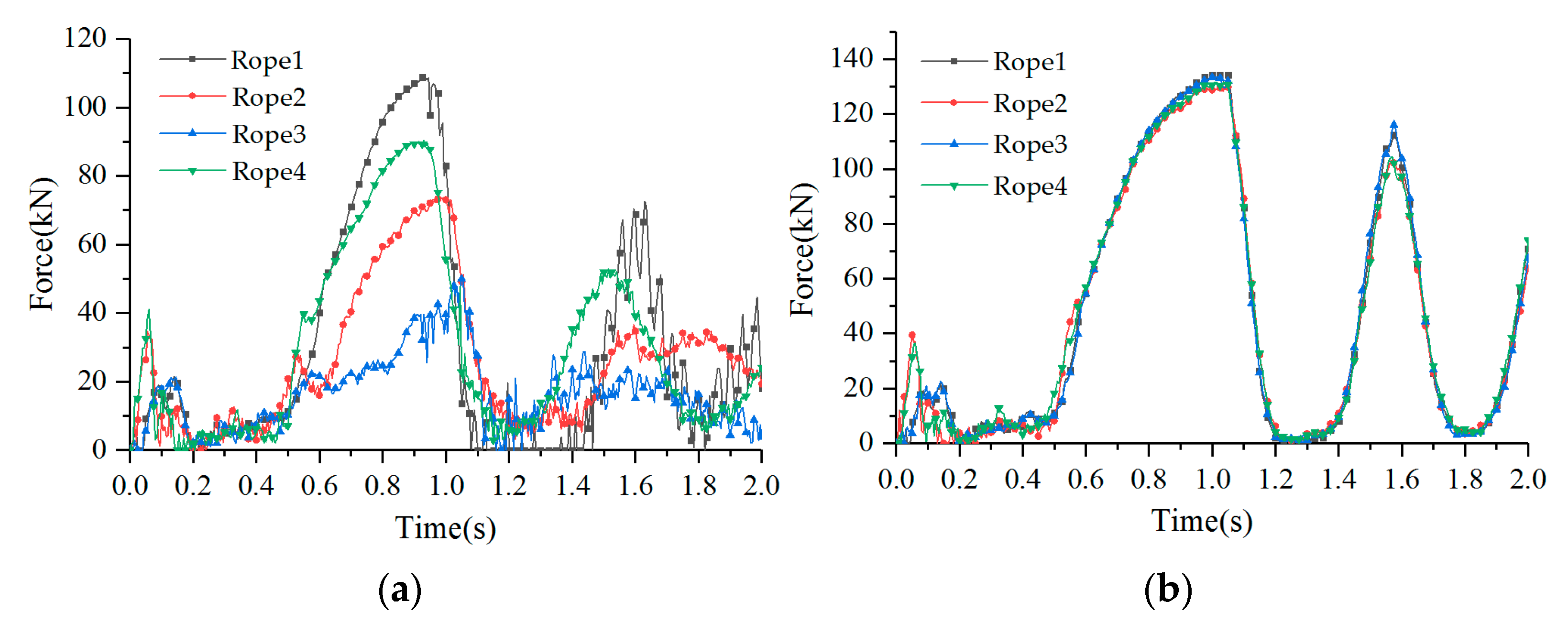
| Accident Level | Distinguish Condition | The Status of the Energy Dissipators |
|---|---|---|
| Level 1 | The primary energy dissipators are not started. | |
| Level 2 | Some of the primary dissipators started but did not reach the limit displacement, and the secondary dissipators did not start. | |
| Level 3 | The primary energy dissipators are all started, some reach the limit displacement, and some secondary energy dissipators are started but did not reach the limit displacement. | |
| Level 4 | The primary energy dissipators are all started, some reach the limit displacement, and the secondary energy dissipators are all started, some reach the limit displacement. |
| Component | Specification | Actual material | Material Model | Type of Element |
|---|---|---|---|---|
| Intercepting net | R16/3/300 | High-strength steel wire | Piecewise_linear_plasticity | Beam |
| Support rope | 1φ22 | 6 × 19s + iwr | Cable_discrete_beam | Beam |
| Suspended rope | 1φ22 | 6 × 19s + iwr | Cable_discrete_beam | Beam |
| Energy dissipator | Gs-8002 | Q235 | Piecewise_linear_plasticity | Beam |
| Suspended frame | B200 × 8 | Q355 | Plastic_kinematic | Beam |
| Building materials | 32#b(Channel steel) | Q355 | Rigid | Shell |
| Formwork | Climbing formwork | Q355 | Rigid | Shell |
| Cases | Falling Materials | Mass (t) | Initial Velocity (m/s) | Energy Dissipator |
|---|---|---|---|---|
| Case 1 | A single building steel | 0.075 | 18.78 | Yes |
| Case 2 | Some building steel | 0.30 | 18.78 | Yes |
| Case 3 | A single climbing formwork | 4.94 | 0 | Yes |
| Case 4 | The whole climbing formwork | 19.76 | 0 | Yes |
| Case 5 | Some building steel | 0.30 | 18.78 | No |
| Case 6 | A single climbing formwork | 4.94 | 0 | No |
| Cases | Energy Dissipator | Intercepting Net | Suspended Frame | Others | Total | ||||
|---|---|---|---|---|---|---|---|---|---|
| Value | Ratio | Value | Ratio | Value | Ratio | Value | Ratio | ||
| Case 1 | 4.3 | 30.3 | 8.3 | 58.5 | 0.3 | 2.1 | 1.3 | 9.1 | 14.2 |
| Case 2 | 19 | 33 | 12 | 20.8 | 0.8 | 1.4 | 25.8 | 44.8 | 57.6 |
| Case 3 | 106 | 66 | 21 | 13 | 3 | 1.9 | 30.6 | 19.1 | 160.6 |
| Case 4 | 575 | 85.3 | 37 | 5.5 | 13 | 1.9 | 48.8 | 7.3 | 673.8 |
| Case 5 | - | - | 15.2 | 26.9 | 4.9 | 8.6 | 36.5 | 64.5 | 56.6 |
| Case 6 | - | - | 23.2 | 17.4 | 62.6 | 46.9 | 47.6 | 35.7 | 133.4 |
| Cases | Support Rope | Suspended Rope | Intercepting Net | Suspended Frame | ||||||||||
|---|---|---|---|---|---|---|---|---|---|---|---|---|---|---|
| Force(kN) | Limit (kN) | Surplus (%) | Primary Energy Dissipator Status | Force (kN) | Limit (kN) | Surplus (%) | Secondary Energy Dissipator Status | Force (kN) | Limit (kN) | Surplus (%) | Stress (Mpa) | Limit (Mpa) | Surplus (%) | |
| Case 1 | 48 | 284 | 83.1 | Phase 1 | 17.8 | 284 | 93.7 | Phase 1 | 34.6 | 924 | 96.3 | 29.7 | 345 | 91.4 |
| Case 2 | 70.9 | 284 | 75.0 | Phase 1 and Phase 2 | 30.4 | 284 | 89.3 | Phase 1 | 131 | 924 | 85.7 | 49.2 | 345 | 85.7 |
| Case 3 | 117 | 284 | 58.8 | Phase 2 and Phase 3 | 143 | 284 | 49.6 | Phase 1 and Phase 2 | 198 | 924 | 78.6 | 226 | 345 | 34.5 |
| Case 4 | 138 | 284 | 51.4 | Phase 2 and Phase 3 | 177 | 284 | 37.7 | Phase 2 and Phase 3 | 655 | 924 | 29.1 | 191 | 345 | 44.6 |
| Case 5 | 173 | 284 | 39.1 | - | 76.5 | 284 | 73.1 | - | 131 | 924 | 85.8 | 135 | 345 | 60.9 |
| Case 6 | 284 | 284 | 0 | - | 161 | 284 | 43.3 | - | 194 | 924 | 79 | 345 | 345 | 0 |
Disclaimer/Publisher’s Note: The statements, opinions and data contained in all publications are solely those of the individual author(s) and contributor(s) and not of MDPI and/or the editor(s). MDPI and/or the editor(s) disclaim responsibility for any injury to people or property resulting from any ideas, methods, instructions or products referred to in the content. |
© 2023 by the authors. Licensee MDPI, Basel, Switzerland. This article is an open access article distributed under the terms and conditions of the Creative Commons Attribution (CC BY) license (https://creativecommons.org/licenses/by/4.0/).
Share and Cite
Liao, L.; Yu, Z.; Liu, D.; Luo, L.; Guo, L.; Tian, X. Design Method and Impact Response of Energy-Consuming High-Fall Flexible Protection System for Construction. Buildings 2023, 13, 1376. https://doi.org/10.3390/buildings13061376
Liao L, Yu Z, Liu D, Luo L, Guo L, Tian X. Design Method and Impact Response of Energy-Consuming High-Fall Flexible Protection System for Construction. Buildings. 2023; 13(6):1376. https://doi.org/10.3390/buildings13061376
Chicago/Turabian StyleLiao, Linxu, Zhixiang Yu, Dong Liu, Liru Luo, Liping Guo, and Xinquan Tian. 2023. "Design Method and Impact Response of Energy-Consuming High-Fall Flexible Protection System for Construction" Buildings 13, no. 6: 1376. https://doi.org/10.3390/buildings13061376
APA StyleLiao, L., Yu, Z., Liu, D., Luo, L., Guo, L., & Tian, X. (2023). Design Method and Impact Response of Energy-Consuming High-Fall Flexible Protection System for Construction. Buildings, 13(6), 1376. https://doi.org/10.3390/buildings13061376






